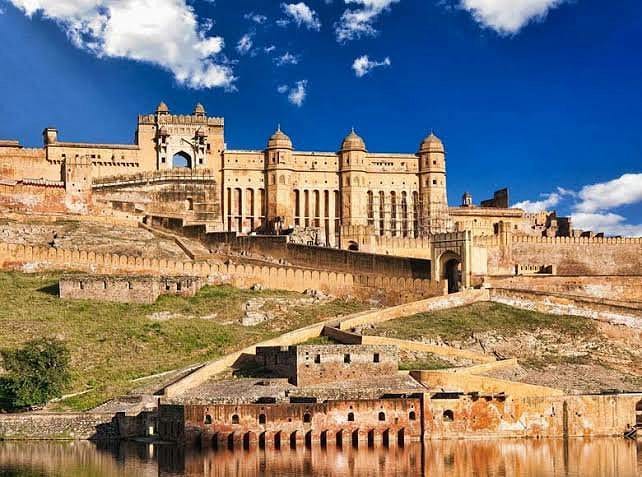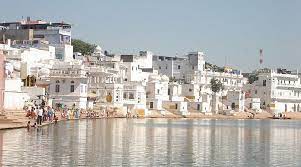About Jaipur
Jaipur city is identified by the pink Dholpuri stones used in its palaces and old houses, which is the specialty of the architecture here. In 1876, the then Maharaja Sawai Ram Singh had decorated the entire city in pink color to welcome Prince Albert of Wales, Queen Elizabeth of England. Since then the city has been named Pink City.
There are many buildings, palaces and forts in Rajasthan, which are still standing in the same condition for centuries. These palaces are discussed all over the world. These historical places also have their own distinct identity. Jaipur, the capital of Rajasthan, has many ancient and historical buildings, which are known for their beauty and structure.
Jaipur is also known as the royal cities of India, here you will see luxurious and beautiful grand hotels. But did you know that Jaipur is also home to some of the world's most famous hotel suites? Yes, there is a Presidential Suite in Raj Palace Hotel which costs approximately US$50,000. This is something everyone would like to experience
About Hawa Mahal
This building with beautifully carved windows is made of sandstone. There would hardly be anyone who would not go to Jaipur and visit Hawa Mahal. Hawa Mahal, built in the shape of a honeycomb, is a landmark of Jaipur. Also known as the 'Palace of the Winds', this five-storey building was built in 1799 by Maharaja Sawai Pratap Singh for the royal ladies to observe everyday life and ceremonies on the street, as they were not allowed to make public appearances without covering up. Their faces were not allowed. This palace has 953 windows or charkhas, which are decorated with intricate designs. A museum within the Hawa Mahal complex houses famous objects such as miniature paintings and ceremonial armour.
About Jal Mahal
Jal Mahal is a five-storey palace, of which the bottom four storeys are always submerged in Mansagar Lake. It is a wonderful example of architecture in itself and tourists love to come here in the evening. In the evening, different types of lights are lit here due to which a reflection of the Jal Mahal is seen in the water which looks very beautiful. This palace is a great example of the architecture of Rajputs.
About Jaigarh Fort
Jaigarh Fort is the most magnificent fort of Jaipur. It is famous for the Jayavna cannon, which is considered to be the largest cannon in the world. Jaigarh Fort was built in 1726 by Sawai Jai Singh II to protect the Amer Fort. It is named after its creator and is also called the Fort of Victory because it has never been conquered. Jaigarh is situated amidst hills covered with thorny bushes, with climbing roads leading to the main gate Dungar Darwaza. The fort is situated on Cheel ka Tila (Hill of the Eagle) on the Aravalli mountain range, overlooking Maotha Lake and Amer Fort. The medieval structure Dewa Burj and the watchtower named 'Cheel Ka Tila' are popular tourist attractions that give you a panoramic view of the entire city
About City Palace
The City Palace in Jaipur is a popular tourist attraction and an important landmark in the city. The City Palace houses the famous Maharaja Sawai Man Singh II Museum and is the residence of the royal family of Jaipur. The palace is an exquisite blend of Indian, Mughal and European architectural styles, which is evident in its grand pillars, jali work or lattice work and carved marble interiors. This huge complex has many buildings, courtyards and beautiful gardens.
Built by Sawai Jai Singh II, the palace is home to the Diwan-e-Khas, a weapons display in the Maharani Palace and the Baggi Khana, a museum of the Maharaja's rides. Chandra Mahal and Mubarak Mahal are also worth seeing. Pritam Niwas Chowk (Mayur Aangan) has doors painted to look like peacock feathers and the Diwan-e-Aam displays the palace's collection of miniature paintings. The Mubarak Palace has costumes and textiles on display and an armory dedicated to preserving finely-crafted daggers and swords.
This palace with walls decorated with mirrors, frescoes and lattices gives a glimpse of the bygone era. The current residents live in Chandra Mahal, a stunning structure with curved balconies and domed roofs, with different architectural styles across its seven floors.
About Amer fort
Amer Fort in Jaipur is famous all over the world. It was built in the 16th century. This fort is an example of Rajasthani architecture and culture. Amer Fort, built on a high hill, looks very huge and beautiful from a distance. If you are a history lover, then you should know about many things related to this fort. Here we are going to tell you some special things about Amer Fort.
It took 100 years to complete the fort
The construction of Amer Fort was started by Raja Man Singh in the late 16th century. However, the existing construction was completed by Sawai Jai Singh II and Raja Jai Singh It took 100 years to complete it during the reign of Raja Man Singh to Sawai Jai Singh II and Raja Jai Singh
Shila Devi Temple in Amer Fort
The story behind the temple is interesting. It is said that Goddess Kali appeared in the dreams of Raja Man Singh and asked him to find her idol on the banks of Jessore (near Bangladesh). The king did as he was told in the dream, but instead of finding the idol of the mother there, he returned to Amer with a large stone. The king's servants cleaned the stone to find the idol of Shila Devi. Due to which the temple of Shila Devi was built.
Sheesh Mahal in Amer Fort
One of the attractive sights inside the fort is the Sheesh Mahal or Mirror Palace, whose walls are carved with concave mirrors. They have been installed in such a way that if even one light comes on, the entire palace sparkles. Sheesh Mahal has been the favorite place of Bollywood directors.
Jaigarh Fort near Amer Fort
Jaigarh Fort was a fort built for the army of the king living in Amer Fort. A 2 kilometer long tunnel was built from Amer Fort, this tunnel connects to Jaigarh Fort. This tunnel was built for a war-like situation, so that the king could be evacuated safely. Seeing such a plan shows that the king was alert about war.
About Chokhi Dhani
At Chokhi Dhani you can experience the rich culture and spirit of Rajasthan. View traditional Rajasthani artefacts, handicrafts, paintings, folklore and sculptures and witness folk dances and songs, puppet shows, magic shows, camel rides, horse riding, fortune telling. Enjoy predicting tellers, parrots and acrobatics. Choki Dani Village Resort is famous for its traditional Rajasthani food. The menu includes dal (lentil curry), baati (baked round bread with ghee on top), churma (sweet), sangri (fried dry vegetable) and gatte ki sabzi (curry made from gram flour). Rajasthani people take their hospitality very seriously.
If you like shopping then understand that Jaipur is no less than a paradise for you. There are plenty of shops to buy gem artwork, handicrafts, costumes, shoes, puppets, purses, bedsheets and Jaipur quilts (razai). Johari Bazaar is a famous tourist destination for buying gems, jewelery and souvenirs. There are dozens of shops selling silver and gold as well as costume jewellery. Visit Tripolia market for lac jewelery and intricately designed lac bangles. Chandpol market is famous for its colorful handicrafts and marble crafts. Bapu Bazaar is a must visit in Jaipur for its leather and textile products and mojaris, shoes made of camel leather. You can also buy fragrances (attar), lehengas, Bandhani dupattas, colorful Lahariya sarees and sandstone artefacts
About pushkar
Tirthguru Pushkar, the place of sacrifice of the creator of the universe Brahma and the place of penance of sages, is situated between Nag mountain. Due to the curse of an angry wife, the only temple of Brahmaji in the country is in Pushkar. Pushkar Sarovar was also created by Brahmaji himself. Just as Prayag is called Tirtharaj, in the same way this pilgrimage is called Pushkar Raj. The deity of Jyeshtha Pushkar is Brahmaji, the deity of middle Pushkar is Lord Vishnu and the deity of Kanishka Pushkar is Rudra. These three Pushkars were made from the lotus flower of Lord Brahma. The country's largest camel fair is held in Pushkar itself in Kartik, in which domestic and foreign tourists come in large numbers.
The caves of sages like Agastya, Vamdev, Jamdagni, Bhartrihari etc. are still present in Nag Pahad as a place of penance in Pushkar, about 11 kilometers north-west of Ajmer, the city of communal harmony. Brahmaji's temple is built at the end of the main market of Pushkar.
Shankaracharya had installed the idol of Brahma in Samvat 713. The present form of the temple was built by Gokalchand Parekh in 1809 AD. This temple is the only ancient temple of Brahmaji in the country. Behind the temple, on Ratnagiri mountain, there is a temple of Savitri, the first wife of Brahmaji, at a height of two thousand three hundred and sixty nine feet above ground level.
About Ajmer
Ajmer city, located at a distance of about 132 kilometers from the capital of Rajasthan, Jaipur, is called the heart of Rajasthan. This city of Rajasthan is a wonderful confluence of historical heritage, culture and adventure. Even today the stories of this city are repeated in history. The city was founded in the 7th century by Raja Ajay Raj Singh Chauhan, the ancestor of Prithviraj Chauhan.
Surrounded by the Aravalli mountain range, this city is ranked among the beautiful tourist destinations of Rajasthan in the country and the world. Revered by both Hindus and Muslims, this city still stands as a symbol of unity, history and beauty with centuries of history behind it. Ajmer is a major center of tourist attraction for its natural beauty and artistry.
In such a situation, if you are planning to visit Rajasthan, then do not forget to include this city located at a distance of only 132 kilometers from Jaipur in your list. This city is a living example of the historical and religious places of Rajasthan. Let us know the major tourist places and history of Ajmer city.
Ajmer Sharif Dargah located in Ajmer city of Rajasthan is one of the major pilgrimage sites for Muslims. This Dargah was built as the last resting place of Moinuddin Chishti. This Dargah was built by the Mughal rulers. There is a belief about this Dargah that be it a king or a fakir, a Hindu or a Muslim, whoever kisses the threshold of this Dargah does not leave empty handed. Every year lakhs of people visit the Dargah of Ajmer Sharif.
The history of Taragarh Fort of Ajmer is linked to the Chauhan rulers. This historical fort was built in the 11th century by Emperor Ajay Pal Chauhan to protect against the invasion of foreigners and Turks and to run his military activities smoothly. This ancient fort still stands with centuries of history behind it. This fort, spread over about 2 square miles on a mountain peak about 1885 feet above sea level, is one of the highest forts in India.
There are 3 huge doors to enter this fort. These are known as Lakshmi Pol, Unta Darwaza and Gaguri Phatak. This fort was rebuilt by Prithviraj Sisodia at the behest of his wife Tara. In such a situation, if you are interested in history then definitely visit this fort.
Foy Sagar Lake:
Foy Sagar Lake located in Ajmer city is one of the major tourist destinations of Ajmer city. This lake was built by an English architect in 1892 to overcome the shortage of water in Ajmer. Let us tell you that the original capacity of this lake is 15 million cubic feet, whose water is spread over 14,000,000 square feet. This lake reflecting the blue sky is a major center of tourist attraction
![]()
![]()
![]()
![]()
![]()
![]()
![]()
![]()
![]()
![]()
![]()


 Zero Processing Fee
Zero Processing Fee









